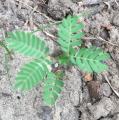
DMT-Nexus member
Posts: 1129 Joined: 12-Jul-2014 Last visit: 18-May-2024 Location: on the world in time
|
This summer I cultivated quite a bit a desmanthus illiniosensis. And now that this long summer is finally coming to an end I've been out harvesting wild desmanthus as well. Last weekend I found a few very large plants that are who knows how old. I only harvested one lateral root from these huge plants. I've also been collecting youpon leaves and the very tiny Passiflora lutea to use as additives. (There's no research I can find on p. lutea, although as it suffers far less herbivory and the subjective effects seem much stronger than p. incarnata, I hypothesize that it has higher alkaloid content). Last nights brew consisted of: 3 grams of very knobby wild desmanthus root bark 3 grams of cultivated desmanthus root bark 3 grams of dried Phalaris arundinacea (grown from seed) This was boiled 3x, combined and reduced. No egg white used. 3 grams of powdered harmala seeds were parachuted, followed 20 min later by half of the desmanthus/ philaris brew. Within 20 min, effects were felt. Very little nausea or discomfort noted. this turned out to be a small dose, roughly comparable to ~3 grams of ACRB. This morning I feel completely rejuvenated. More people should brew the humble bundleflower, you may be plesently supprised. Ps. Desmanthus probably isn't the best plant for beginners. For that I would recommend acacia confusa. But once one is familiar with oral DMT, desmanthus is a logical route to explore for those who wish to be self sufficient, as one can grow quite a bit in one growing season. At least in my 300+ day growing season. Also I fed the brew to my plants 4 or 5 times, I have no idea if this help their content but they sure seemed happy after. BundleflowerPower attached the following image(s):  image.jpg (4,537kb) downloaded 439 time(s).
|
|
|
|
|

DMT-Nexus member
Posts: 1263 Joined: 01-Jun-2014 Last visit: 10-Aug-2019
|
 Very good, brother Sir, we would really love to know how these (sans phalaris perhaps) would work out if boiled with russian olive leaves (or other eleagnus) together (and omitting rue). Keep on the good work, thx and 
|
|
|

DMT-Nexus member
Posts: 1129 Joined: 12-Jul-2014 Last visit: 18-May-2024 Location: on the world in time
|
Never worked with russian olive. Does it grow along the gulf coast? I've looked for it at nuseries but no luck. Next spring I'll be planting a caapi vine at home and perhaps some in the woods. About 20 or 30 miles south of me it never freezes so it should grow fine on a large tupelo or cypress tree. I have a little seed grown chacruna to go with it. BundleflowerPower attached the following image(s):  image.jpg (2,384kb) downloaded 418 time(s).
|
|
|

DMT-Nexus member
Posts: 1263 Joined: 01-Jun-2014 Last visit: 10-Aug-2019
|
We don't understand 'gulf coast'. Russian olive thrives in the same harsh continental climate as Illinois Bundleflower. But it is also native to NW Iran, Anatolia and riparian areas of what was once greater northern Scythia/Tartary. Their leaves have a silvery velvety apperance and we believe the ancient avestan word 'gao-kerena' (cow ear) aka 'white haoma' may perhaps be connected to this plant. It can be seen here from 0:46. Many more eleagnus species are found in China.
|
|
|

DMT-Nexus member
Posts: 1129 Joined: 12-Jul-2014 Last visit: 18-May-2024 Location: on the world in time
|
Sorry brother, I was referring to the Gulf of Mexico. North central gulf coast. I was reading that it is naturalized in much of North America. My landscape is coastal, major river delta, hardwood forest along rivers, and swamp / marsh further away from rivers. Paradoxically the highest ground is right next to rivers and streams. It's very wet here also , 60+ inches of rain per year, zone 9b
|
|
|

DMT-Nexus member
Posts: 1263 Joined: 01-Jun-2014 Last visit: 10-Aug-2019
|
 image: theater of war BundleflowerPower wrote:Never worked with russian olive.I've looked for it at nuseries but no luck. You won't find russian olive at colonial nurseries, as THEY seem to have realized that it's a full blown invasion, the counter lalo air force (the bird people) prepared it with the required stealth but it is out now & the battle is on. You will probably find russian olive reconnaissance squad in that river delta... Brother Sir, could the wild desmanthus you collected be Desmanthus leptolobus?
|
|
|

DMT-Nexus member
Posts: 1129 Joined: 12-Jul-2014 Last visit: 18-May-2024 Location: on the world in time
|
That day I harvested 2 plants, the smaller one was deffenentlly D. Illiniosensis, as it still had a few seed pods attached. The larger one did not have pods and was almost de-foliated, so it's entirely possible it was D. leptolobus. They were growing in a very large spillway, which is used to divert water from the river, just upstream from my city, in order to save the city from flooding when the river gets so high that it may top the levees. The place floods each year so all the plants are under water for a month or two each spring, and when the spillway is opened the water rushes through and can be 10 - 20 feet deep. The soil is very rich in nutrients as well, perhaps this plays a part in potentcy?
Russian olive may grow here, from what I've read it can grow in a multitude of conditions. In fact it probably grows in the spillway, as seeds wash down the river from the mid west U.S., they're are several trees that grow there and along the river bank that only occur up north, such as maple that's on the Canadian flag.
Thanks for the video, I'm going to watch as soon as I get off work.
|
|
|

DMT-Nexus member
Posts: 306 Joined: 04-Mar-2012 Last visit: 20-Jul-2025 Location: temperate dweller
|
Harvested one of my leptos the other day, wasn't expecting it to have this nice, usable root. 6 grams for one potted and constrained plant in one growing season! You could easily have a field of this stuff. This is an awesome plant, it'll produce a number of seed pods in the first year. It's looking like a #1 choice for temperate renewable spice, so long as the phytochemical analyses are correct. I have not tried to brew any yet. Really glad this is being spread throughout the ethnobotanical community  kerelsk attached the following image(s):  20141028_113121.jpg (2,409kb) downloaded 342 time(s).
|
|
|

DMT-Nexus member
Posts: 1129 Joined: 12-Jul-2014 Last visit: 18-May-2024 Location: on the world in time
|
That's right, desmanthus can produce quite a bit of root bark in one season, plus it matures and sets seed the first year. I don't feel as bad using an entire plant if it's offspring get a shot to live. Have you ever fed the brew to your plants? I don't know if it helps potency but they grow extremely vigorous after.
|
|
|

Dreamoar

Posts: 4711 Joined: 10-Sep-2009 Last visit: 18-Dec-2025 Location: Rocky mountain high
|
I am very pleased to see someone finally taking it upon themselves to work with these teachers... and sharing their results with the community. Kudos to you!   
|
|
|

DMT-Nexus member
Posts: 306 Joined: 04-Mar-2012 Last visit: 20-Jul-2025 Location: temperate dweller
|
Never would have figured to feed a brew to my plants... I wonder if it'd be a good idea to feed just about any tea to your plants. I've heard in the Amazon all the decaying leaf matter makes the rivers acidic, and many plants are slight acid-loving. This was just the first trial year growing the leptos. They loved the greenhouse they were in, with full sun all day. Once the taproot reached the bottom of the pot they seemed to stop growing. Will have to try direct seeding next year, they should do a lot better with unlimited room. I really wish I had an easier way to figure out if there's usable amounts of dmt in these roots aside from bioassay 
|
|
|

DMT-Nexus member
Posts: 557 Joined: 12-Jul-2012 Last visit: 01-Jan-2021
|
Out in the field some aussies do a burn test on Acacia foliage, sniffing the smoke, and select the most DMT smelling specimen for further investigation. Perhaps the same protocol might apply to comparing dried root bark from Desmanthus?
If its even vaguely accurate it could help not just in deciding on wild populations to harvest, but bark from a fixed size of lateral roots on cultivated plants could be tested and the best candidates could be chosen to grow another year and produce seed for the next generation.
Just a thought.
|
|
|

DMT-Nexus member
Posts: 1129 Joined: 12-Jul-2014 Last visit: 18-May-2024 Location: on the world in time
|
That's fascinating, the burn test. I'll have to try that.
Kerelsk, what type of climate do you have? How long is your growing season? I don't think people realize just how large desmanthus can become. I've seen them over 8 feet tall with tap roots 4 inches in diameter. Here at least, the best time to harvest seems to be now, the end of summer coinsides with the begining of the dry season. They're pretty water starved and looking ragged.
|
|
|

DMT-Nexus member
Posts: 401 Joined: 31-May-2014 Last visit: 30-Dec-2023 Location: The confluence
|
For whatever interest there may be; a couple months ago I did an extraction on a small sample of wild d. illinoensis that were immature and harvested in early summer. The extraction yielded .1% crystal (11mg for the 11grams of fresh uncured root bark) and yet unmeasured quantity of "goo" with an a/b using long (24hr) soaks and re a/b ala earthwalker. I have since collected a much larger sample and have found some mature specimens attaining at least half the dimensions you describe, bundleflowerpower. I live in the area of the confluence of two great rivers in the u.s. Illinoensis is quite prolific here but, I've only seen the very large specimens growing in wet loamy soil. Two inch diameter roots at three feet in length are not unusual here in the right circumstances. I will post something more thorough in the desmanthus workspace in the collaborative research project, once I have done a bioassy. One note I will offer is hitting the roots with a hammer has saved my fingernails. The inside of the root is much harder and doesn't come apart with the bark. thank you for the courageous efforts bundleflowerpower. I have been, perhaps, overly concerned with hordenine and gramine. I only recently noticed the cache of data on these in the phallaris threads. "We dance round in a ring and suppose,
while the secret sits in the middle and knows." Robert Frost
|
|
|

DMT-Nexus member
Posts: 1129 Joined: 12-Jul-2014 Last visit: 18-May-2024 Location: on the world in time
|
Nice. It's good to know people are working with this plant. They're pretty cool, when they're young they're leaves look like little transmitters the way they track the sun.
Btw, if anyone is interested I have thousands of seeds from my plants, which where purchased from a reliable vendor. I also have seeds from plants I found in several locations here and there. Pm me.
On a side note, D. Illinioensis seems to be salt tolerant, to what extent I'm not shore, but I found a colony growing a few days ago about 100 yards from the shore of a large tidal lake.
|
|
|

DMT-Nexus member
Posts: 1129 Joined: 12-Jul-2014 Last visit: 18-May-2024 Location: on the world in time
|
Update: Today I decided to make another brew. I used 5 g desmanthus root bark, and added the half of the brew from the other day, to make ~10 g. I also added 2 leaves from my crossvine. This time I brewed the p. Harmala seeds together with the desmanthus in the same brew. I used 4 g of harmal. Drank in the woods, half, followed by the other half 20 min later. I also chewed 2 Passiflora leaves from a wild vine. It was fairly powerful, but not quite a full dose. The forest looked unreal and more alive than I've ever seen it. Who would've known a simple plant that most people would call a weed was capable of THIS? Just wow. Anyway, I also found a few passion vines. They're leaves just popped out at me, even in the corner of my eye when I was looking the other way. Passion vines seem to prefer growing on plants and trees with similar leaf structure, like ragweed and sweet gum. Also found one growing on the root of a large tree which blew over. BundleflowerPower attached the following image(s):  image.jpg (1,200kb) downloaded 239 time(s). image.jpg (1,344kb) downloaded 237 time(s).
|
|
|

DMT-Nexus member
Posts: 67 Joined: 06-Nov-2013 Last visit: 03-Dec-2021
|
Love this thread and love the work you are doing with this often overlooked coldhardy plant... I plan on working with this next growing season.
It would be quite interesting to get some solid framework laid out for the use of this potential teacher plant.
I would be very interested in seeds from some of your plants.
|
|
|

DMT-Nexus member
Posts: 1129 Joined: 12-Jul-2014 Last visit: 18-May-2024 Location: on the world in time
|
And that's why I truly love the nexus. Kudos to the traveler. I used to post on another forum under a different name, when I voiced my intention of attempting to grow and make a brew from bundle flower & Passiflora, I was slammed because it wouldn't work. Too many people believe what they read online and repeat it without trying it themselves. I've seen conventional wisdom proved wrong so times it's ridiculous.
And it's not that desmanthus is my only option, I live in zone 9b so I can and do grow mimosa tenuiflora and p. Viritis. I just find desmanthus to be a fascinating plant. And it seems that the published content of 0.34% is close to the mark. I've worked with ACRB many times (gonna grow a tree next spring) and desmanthus seems to be about 1/3 as potent. This puts it's alkaloid content in the same ballpark as chacruna.
And btw anyone here on the nexus who wants seeds is welcome, free of charge of course. I have seeds from wild populations along the gulf coast (including salt tolerant plants) as well as seeds from the same vendor that I purchased authentic chacruna and m. Hostilis seeds from.
|
|
|

DMT-Nexus member
Posts: 1129 Joined: 12-Jul-2014 Last visit: 18-May-2024 Location: on the world in time
|
One other thing is anyone who is interested in working with unconventional plant teachers should deffinantly read the entheogen review. It's really long but worth every minute, full of info on how to go about working with bundleflower, philaris grass, etc. Here's the full text: https://archive.org/stre...n%20Review%20Complete%20(1992-200  _djvu.txt
|
|
|

DMT-Nexus member
Posts: 1263 Joined: 01-Jun-2014 Last visit: 10-Aug-2019
|
 Thx for the update.
|